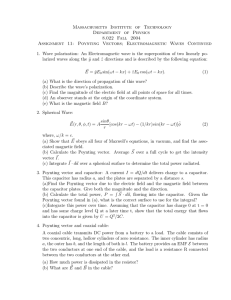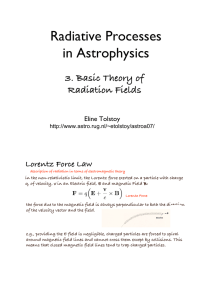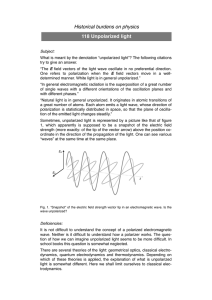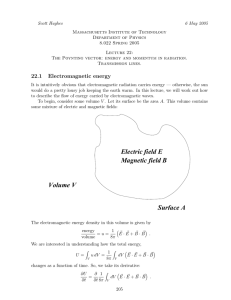Massachusetts Institute of Technology Department of Physics Physics 8.022 - Fall 2002
advertisement
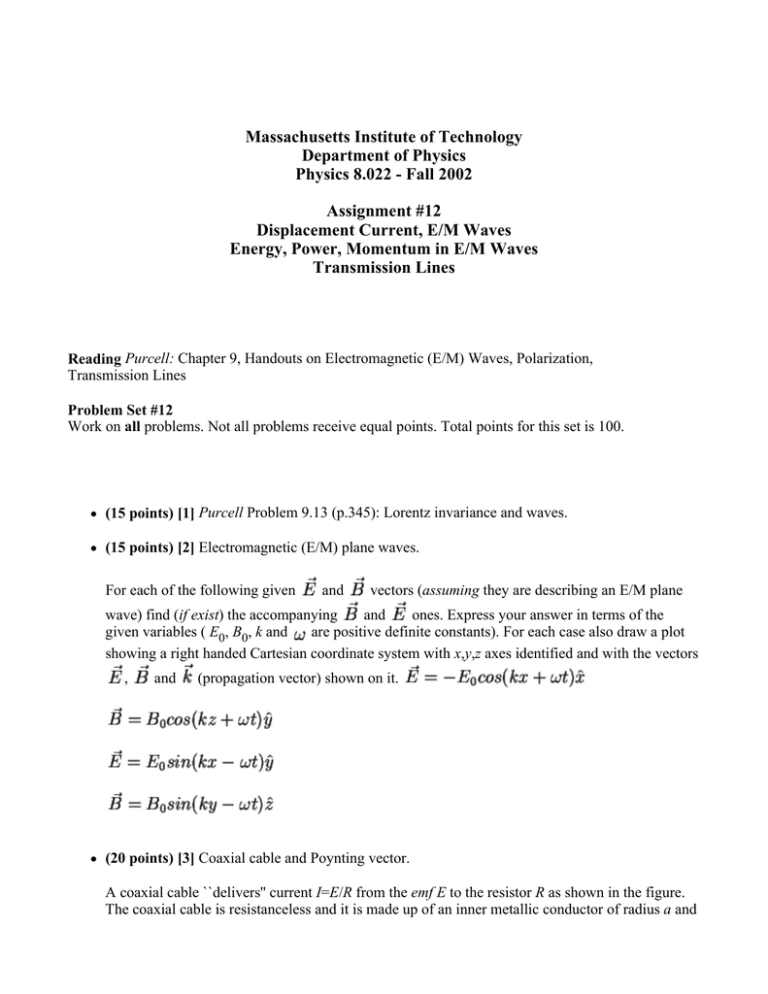
Massachusetts Institute of Technology Department of Physics Physics 8.022 - Fall 2002 Assignment #12 Displacement Current, E/M Waves Energy, Power, Momentum in E/M Waves Transmission Lines Reading Purcell: Chapter 9, Handouts on Electromagnetic (E/M) Waves, Polarization, Transmission Lines Problem Set #12
Work on all problems. Not all problems receive equal points. Total points for this set is 100. z
(15 points) [1] Purcell Problem 9.13 (p.345): Lorentz invariance and waves.
z
(15 points) [2] Electromagnetic (E/M) plane waves.
For each of the following given
and
vectors (assuming they are describing an E/M plane
wave) find (if exist) the accompanying
and
ones. Express your answer in terms of the
given variables ( E0, B0, k and
are positive definite constants). For each case also draw a plot
showing a right handed Cartesian coordinate system with x,y,z axes identified and with the vectors
,
z
and
(propagation vector) shown on it.
(20 points) [3] Coaxial cable and Poynting vector.
A coaxial cable ``delivers'' current I=E/R from the emf E to the resistor R as shown in the figure.
The coaxial cable is resistanceless and it is made up of an inner metallic conductor of radius a and
an outer metallic conductor of radius b. Our goal is to extend the definition of the Poynting vector
to static fields and show that its physical significance remains the same, i.e., a measure of power
flow.
{
Find the
and
fields in the space in between the two conductors of the coax cable and
construct the Poynting vector
{
{
{
z
. Where does
Convince yourself this is the only region of space where
``poynt'' to?
is non-zero.
Integrate
over the cross section of the cable and show that the total power flowing
through the cable is E2/R. Is this what you expected?
The leads of the battery are now reversed. Does the direction of
expected?
change? Is this what you
(15 points) [4] Radiation from the Sun.
At the top of the atmosphere the average radiant flux from the Sun is
.
Although this radiation consists of a spectrum of frequencies, many of the interesting proporties
do not depend on frequency and can therefore be calculated by using the methods described for
monochromatic waves.
{ What is the average energy density in the solar radiation at the top of the atmosphere? { What is the average momentum density? { What average force would the radiation exert on a completely absorbing surface with an
area of 1m2 oriented perpendicular to the Earth-Sun line? { What is the average value of E in the wave? 0
z
(15 points) [5]
and
fields in a capacitor.
We have worked in class on the
and
(radius R, distance l) driven by an alternating current
fields in a parallel circular plate capacitor
. In doing this
we have ignored fringing effects,
assumed
spatially uniform and also assumed I being ``slowly varying'', i.e.,
.
{
Show that our assumption of uniform
field is in violation of Faraday's law.
{
Estimate the non-uniformity of
{
shown in figure. Is
going to be decreasing or increasing with increasing r?
Find the relative error
and compare it with one of our assumptions (this saves
by calculating the circulation of
around the path
us!).
z
(20 points) [6] Wave Polarization.
An electromagnetic wave is the superposition of two linearly polarized wave along the
and
directions and is described by the following equation:
{
{
{
{
What is the direction of propagation of the wave? What is the polarization status of this wave? Find the magnitude of the electric field at all points of space for all times. An observer stands at the origin of the coordinate system. Draw a diagram showing the
vector
at
Erotokritos Katsavounidis
.
![Hints to Assignment #12 -- 8.022 [1] Lorentz invariance and waves](http://s2.studylib.net/store/data/013604158_1-7e1df448685f7171dc85ce54d29f68de-300x300.png)







